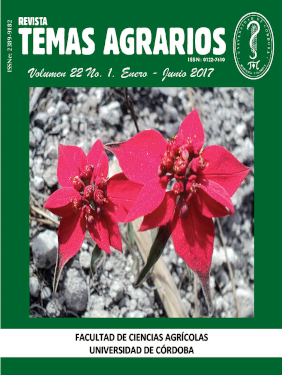Characterization and extraction of citrulline of the watermelon rind (Citrullus lanatus "thunb") consumed in Valledupar
Caracterización y extracción de citrulina de la corteza de la sandía (Citrullus lanatus “thunb”) consumida en Valledupar
How to Cite
Durán, R., Villegas, M., & Nieves, I. (2017). Characterization and extraction of citrulline of the watermelon rind (Citrullus lanatus "thunb") consumed in Valledupar. Sour Topics, 22(1), 60-67. https://doi.org/10.21897/rta.v22i1.916
Dimensions
license

This work is licensed under a Creative Commons Attribution-NonCommercial 4.0 International License.
Show authors biography
Article visits 1924 | PDF visits
Downloads
Download data is not yet available.
- Akashi, K., Miyake, C. and Yokota, A. 2001. Citrulline, a novel compatible solute in drought-tolerant wild watermelon leaves, is an efficient hydroxyl radical scavenger. FEBS Letters, 508(3), 438–42.
- Al-Sayed, H. and Ahmend, A. 2013.Utilization of watermelon rinds and sharlyn melon peels as a natural source of dietary fiber and antioxidants in cake. Journal Annals of Agricultural Science 58(1): 83-95.
- Boyde, T. and Rahmatullah, M. 1980. Optimization of Conditions for the Colorimetric Determination os Citrulline, Using diacetyl Monoxime. Journal Analytical Biochemestry 107: 424-430.
- Curis, E., Nicolis, I., Moinard, C., Osowska, S., Zerrouk, N.,
- Bénazeth, S., Cynober, L. 2005. Almost all about citrulline in mammals. Amino Acids, 29(3), 177–205.
- Desamero, N., Adelberg, J., Hale, A., Young, R. and Rhodes, B. 1993. Nutrient utilization in liquid/membrane system for watermelon micropropagation.Journal Plant Cell,Tissue and Organ Culture 33(3): 265-271.
- Drewes, S., George, J. and Khan, F. 2003. Recent findings on natural products with erectile-dysfunction activity. Journal Phytochemistry 62(7): 1019-1025.
- Fang, Y., Yang, S. and Wu, G. 2002. Free Radicals, Antioxidants, and Nutrition. Journal Nutrition 18(10): 872-879.
- Fila, W., Itam, E., Johnson, J., Odey, M., Effiong, E., Dasofunjo, K., Ambo, E. 2013. Comparative Proximate Compositions of Watermelon Citrullus Lanatus, Squash Cucurbita Pepo’l and Rambutan Nephelium Lappaceum. International Journal of Science and Technology. 2(1): 81-88.
- Guimaraes, R., Freitas, M. y Silva, V. 2010. Bolos simples elaborados com farinha da entrecasca de melancia (Citrullus vulgaris, sobral): avaliação química, fisica e sensorial. Revista de Ciencia y tecnologia de Alimentos 30(2): 354-363.
- Jayaprakasha, G., Murthy, K. and Patil, B. 2011. Rapid HPLC-UV method for quantification of L-citrulline in watermelon and its potential role on smooth muscle relaxation markers. Journal Food Chemistry 127: 240-248.
- Lee, S. and Kader, A. 2000. Preharvest and postharvest factors influencing vitamin C content of horticultural crops. Journal Postharvest Biology and Technology 20(3): 207-220.
- Pereira S., Miguel, D. and Carvalho, E. 2011. Caracterização de farinha da entrecasca de melancia (citrullus lanatus) produzida na região sul do tocantins. Cadernos de Pós-Graduação da FAZU.
- Perkins-Veazie, P., Collins, J., Pair, S., Warren, R. and Roberts, W. 2001.Lycopene content differs among red-fleshed watermelon cultivars.Journal of the Science of Food and Agriculture 81(10): 983-987.
- Piñeiro, V., Ortiz-Moreno, A., MoraEscobedo, R., Hernández-Navarro, M. D., Ceballos-Reyes, G., and Chamorro-Cevallos, G. 2010. Effect of L-arginine oral supplementation on response to myocardial infarction in hypercholesterolemic and hypertensive rats. Plant Foods for Human Nutrition (Dordrecht, Netherlands), 65(1), 31–37.
- Rimando, R., Perkins-Veazie, P. 2005. Determination of citrulline in watermelon rind. Chromatogr A.1078 (1-2): 196–200.
- Rodríguez, M., Lemma, A. 2012. Diseño experimental y optimización de procesos. 2012. Ediciones casa do espiritu amigo fraternidad fe e amor, Campinas, Sao Paaulo, Brasil, p153-162.
- Romero, M., Platt, D., Caldwell, R. and Caldwell, R. 2006. Therapeutic use of citrulline in cardiovascular disease. Cardiovascular Drug Reviews, 24(3-4), 275–90.
- Santos M., Meneses R., y Cunha M. 2015. Aproveitamento integral melancia (Citrullus lanatus) na produção de derivados lacteos. Instituto federal de educação, Ciência e tecnologia de Alagoas (IFAL). Campus Satuba (2015)
- Secretaria de Agricultura del departamento del Cesar. 2015. Cesar en cifras. Boletin en impresión.
- Tarazona, M., Viegas, J., Moldao-Martin, S. and Aguayo, E. 2011. Bioactive compounds from flesh and by-product of fresh-cut watermelon cultivares. Journal Science of Food and Agriculture 91(5): 805-812.
- Tarazona, M. y Aguayo, E. 2012. Aprovechamiento de subproductos procedentes de la industria de procesado en fresco: obtención de un zumo funcional de sandía. Tesis de Doctor.
- Universidad Politecnica de Cartagena, España.
- Villegas, M., Nieves, I. y Durán, R. 2015. Elaboración de una bebida no alcohólica a partir del extracto del aminoácido L-citrulina, obtenido de la cáscara de sandía (citrullus lanatus) generada como residuo en la ciudad de Valledupar. Tesis Ingeniero Agroindustrial, Universidad Popular del Cesar, Valledupar.
- Wada, W. 1930. Über citrullina, eine neue Aminosäure im Presssaft der Wassermelone, Schmid Citrullus vulgaris. Jornal Biochemical 12: 224-420.




















